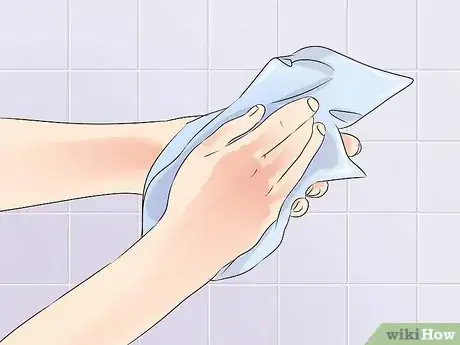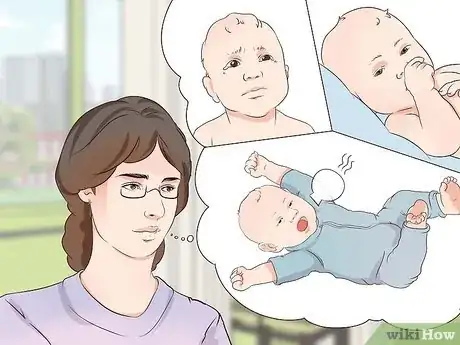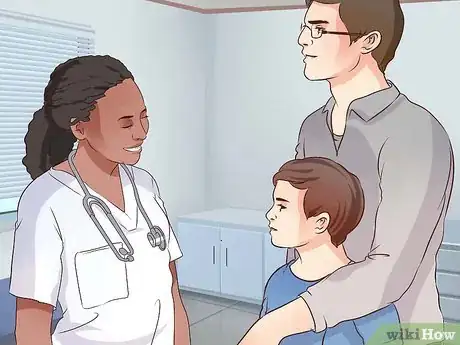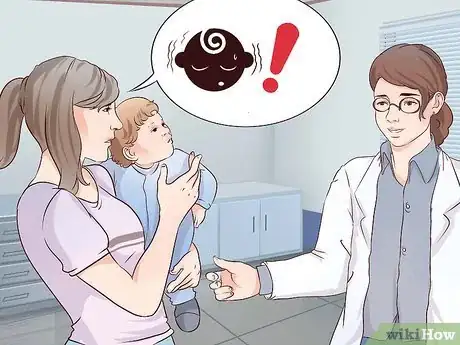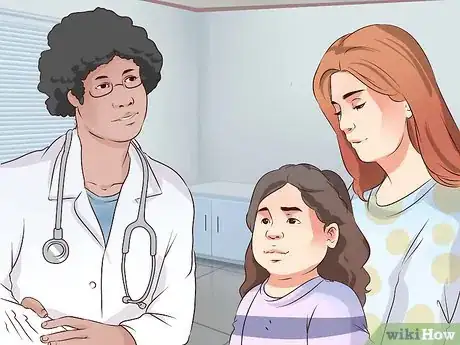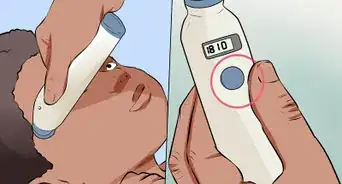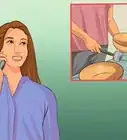This article was co-authored by Laura Marusinec, MD and by wikiHow staff writer, Hannah Madden. Dr. Marusinec is a board certified Pediatrician at the Children's Hospital of Wisconsin, where she is on the Clinical Practice Council. She received her M.D. from the Medical College of Wisconsin School of Medicine in 1995 and completed her residency at the Medical College of Wisconsin in Pediatrics in 1998. She is a member of the American Medical Writers Association and the Society for Pediatric Urgent Care.
There are 10 references cited in this article, which can be found at the bottom of the page.
This article has been viewed 49,438 times.
It can be scary to see a child you care about come down with a fever. While a fever may be beneficial in fighting off an underlying infection, it can also make a child very uncomfortable.[1] You can often help them feel better by taking a few steps to gently reduce the fever with natural methods. However, take them to the doctor if they develop serious symptoms, show signs of dehydration, or have an underlying health condition.
Steps
Using At-Home Remedies
-
1Bathe your child in lukewarm water to cool them down. Place your child in a tub with 1 to 2 inches (2.5 to 5.1 cm) of room-temperature water, then gently sponge the water over them. Bathe them for 15-20 minutes to cool their body temperature. The evaporation of the water will cause your child’s temperature to go down.[2]
- Don't use cold water. It may seem counterintuitive, but a rush of cold water will cause shivering and will, in turn, raise their body temperature.[3]
-
2Place cool, damp washcloths on your kid’s forehead and wrists. Dampen the washcloths with lukewarm water, then wring them out. Lay them against your child’s skin to cool them down. Let the washcloths sit for about 20 minutes to reduce their core body temperature and temporarily lower the fever.
- Don’t use cold washcloths to cool down your child because they will make them shiver.
-
3Increase your child’s fluid intake. Make sure your child has access to water, milk, or juice so they can stay hydrated. Extra hydration will make it easier for their body to fight infection and lower the fever on their own.[4]
- Try to stay away from dehydrating liquids, like soda.
- For infants, you can breastfeed or offer formula more frequently. Don't give water to babies under 6 months old.
-
4Allow the fever to run its course. You don’t necessarily need to actively try to bring down a child’s fever. In fact, riding out a mild fever might be the best way to deal with one. Fevers make certain parts of the immune system work harder, which can help your child get over colds faster than with medication.[5]
- It can be hard to step back and recognize that there’s nothing more you can or should do as a caretaker to bring down your child’s fever. Sometimes, just reducing the symptoms is enough and can go a long way to helping your child bravely endure this rough patch.
-
5Monitor your child’s temperature consistently. Riding out a fever still involves a checkup of the numbers to make sure they aren’t getting worse. Try to check on your kid’s temperature every 2 to 3 hours or so. Typically all you need is a digital thermometer, though other options, such as the more expensive temporal artery thermometers or ear thermometers are also available.[6]
- Rectal thermometers provide the most accurate readings for infants. These should have a flexible tip and a wide handle.[8]
- Wait at least 20 minutes after a bath or after feeding your child to take their temperature. These are factors which could affect the reading.[9]
- It's especially important to monitor the temperature in a child under 2 years old.
Warning: Seek medical attention right away if your child’s fever is above 104 °F (40 °C).[7]
Keeping Your Child Comfortable
-
1Tend to your child’s needs. In your role as caretaker, making the child feel as secure as possible during the 3 to 4 days that it normally takes for a fever to go away will increase their comfort level. If your kid is old enough to talk, ask them what they need and how to make them feel more comfortable while they are sick.[10]
- If they want company while they lay bored in bed, try to stay by their side. If they want to be alone, check in on them occasionally.
-
2Encourage your kid to rest. When your child has a fever, they should exert minimal effort. If possible, this means they should refrain from going to school, roughhousing with friends, and playing sports until the fever subsides. This way, the fever has a lower chance of being prolonged or worsened and your child has a higher shot at a much faster recovery. This also means you reduce the chance of your child spreading the infection to others.[11]
Tip: Find activities like coloring books, educational TV shows, or workbooks to give your child something to do while they rest.
-
3Dress your child in light, breathable clothing. Fevers can be uncomfortable, but you can mitigate that by choosing cotton or linen clothes to keep your child cool. If they are staying home from school or daycare, keep them in pajamas all day if you’d like to.[12]
- Cover your child with a light sheet or blanket while they are sleeping, but avoid using heavy comforters or quilts.
When to Seek Medical Care
-
1Take your child to the doctor if they have severe symptoms. While you don’t need to worry immediately, a fever may be a sign of a serious illness. It’s possible your child needs medical care to help them recover. Get your child examined by their doctor if they have a mix of the following symptoms:[13]
- Abdominal pain, back pain, or pain with urination
- Lethargy
- Excessive fussiness or unusual drowsiness
- Severe cough, wheezing, or trouble breathing
- Sore throat that is severe or lasts longer than three days
- Ear pain
- Stiff neck or severe headaches
- Vomiting
- Diarrhea that is frequent, has blood, or lasts more than a few days
-
2Call your doctor immediately if their fever is higher than 104 °F (40 °C). Try not to worry, but your child may need medical care if their fever is high or won’t go away. Check with your child’s doctor to find out if you need to come in for an appointment or provide additional treatments. This will help your child feel better faster.[14]
-
3Get your child quick medical treatment if you see signs of dehydration. In some cases, a fever can lead to dehydration, which can be serious. Since dehydration can quickly become harmful for a child, take your child to the doctor, an urgent care center, or the emergency room as soon as you suspect they’re dehydrated. Fortunately, your child’s doctor can help them get the fluids they need to feel better. Watch for the following symptoms of dehydration:[17]
- Excessive sleepiness, fussiness, or tiredness
- Dry/sticky mouth
- Thirst
- Decreased urination
- Dry skin
- Sunken soft spot in babies
- In infants, no wet diapers for 3 hours
-
4Call your child’s doctor if they have an existing health condition. If your child has a weakened immune system, a fever may become more serious quickly. To be safe, consult your child’s doctor to find out if they recommend you take your child to the doctor or try a different treatment. This will help your child recover faster.[18]
- Check with your child’s doctor prior to giving your child any new medications.
-
5Ask the doctor before treating with ibuprofen or acetaminophen. While over-the-counter pain relievers like Advil and Tylenol are usually safe, they can have side effects and may not be right for your child. Additionally, dosing should be based on your child’s age, weight, and overall health. Talk to your doctor to make sure you’re giving your child this medication safely.[19]
- Your doctor may have provided you with dosing instructions at your child’s last check-up. If this is the case, it’s okay to follow that advice.
Warning: Never give your child Aspirin. Aspirin has been linked with Reye’s syndrome, which can be fatal.[20]
-
6Seek emergency medical attention if your child has a seizure. In some cases, high fevers can lead to seizures, which can look like convulsions or fainting. Keep your child safe by rolling them on their side, keeping anything out of their mouth, and calling emergency services if their fever lasts more than 5 minutes.[21]
- If the seizure lasts less than 5 minutes, you should still take your child to a hospital right away, but you don’t need to call an ambulance.[22]
Warnings
- Never use rubbing alcohol to reduce a fever.⧼thumbs_response⧽
- Do not give aspirin to children under age 18, as it has been associated with a condition called Reye's syndrome. This can be very dangerous and even fatal.[23]⧼thumbs_response⧽
- Have your child evaluated immediately if they have a fever due to being in a hot environment.⧼thumbs_response⧽
- Always consult with your child’s doctor prior to administering a new medication or dose.⧼thumbs_response⧽
References
- ↑ https://medlineplus.gov/ency/article/003090.htm
- ↑ https://www.mayoclinic.org/diseases-conditions/fever/in-depth/fever/ART-20050997?p=1
- ↑ https://www.mayoclinic.org/diseases-conditions/fever/in-depth/fever/ART-20050997?p=1
- ↑ https://www.cdc.gov/H1N1flu/childcare/toolkit/pdf/email_parents032410.pdf
- ↑ https://www.mayoclinic.org/diseases-conditions/fever/in-depth/fever/ART-20050997?p=1
- ↑ https://www.mayoclinic.org/diseases-conditions/fever/in-depth/fever/ART-20050997?p=1
- ↑ https://health.clevelandclinic.org/kids-fevers-when-to-worry-when-to-relax/
- ↑ http://www.nhs.uk/Conditions/pregnancy-and-baby/Pages/how-to-take-your-babys-temperature.aspx
- ↑ http://www.nhs.uk/Conditions/pregnancy-and-baby/Pages/how-to-take-your-babys-temperature.aspx
- ↑ https://www.mayoclinic.org/diseases-conditions/fever/diagnosis-treatment/drc-20352764
- ↑ https://www.cdc.gov/H1N1flu/childcare/toolkit/pdf/email_parents032410.pdf
- ↑ https://www.mayoclinic.org/diseases-conditions/fever/diagnosis-treatment/drc-20352764
- ↑ https://www.mayoclinic.org/diseases-conditions/fever/in-depth/fever/ART-20050997?p=1
- ↑ https://www.mayoclinic.org/diseases-conditions/fever/symptoms-causes/syc-20352759
- ↑ https://www.mayoclinic.org/diseases-conditions/fever/diagnosis-treatment/drc-20352764
- ↑ https://www.mayoclinic.org/diseases-conditions/fever/diagnosis-treatment/drc-20352764
- ↑ http://www.cdc.gov/h1n1flu/homecare/fluidlosstips.htm
- ↑ https://www.health.harvard.edu/blog/worry-childs-fever-2017072512157
- ↑ https://www.mayoclinic.org/diseases-conditions/fever/diagnosis-treatment/drc-20352764
- ↑ https://www.nationwidechildrens.org/conditions/fever
- ↑ https://www.health.harvard.edu/blog/worry-childs-fever-2017072512157
- ↑ https://www.health.harvard.edu/blog/worry-childs-fever-2017072512157
- ↑ https://www.nationwidechildrens.org/conditions/fever
About this article
To lower your child’s fever naturally, bathe them in lukewarm water, which will help reduce their body temperature. You can also place cool, damp washcloths on your child’s forehead or wrists to temporarily reduce the fever. While your child has the fever, encourage them to rest in bed or on the sofa, and keep them home from school so they can use their energy to recover. Make sure they dress in light cotton clothing, which will help heat escape from their body. However, keep a blanket nearby for extra warmth in case they start shivering. Although your child will normally fight off a fever after 3 to 4 days, take them to a doctor if they experience abdominal or back pain, unusual drowsiness, or severe coughing. For tips from our Medical co-author, including how to take your child’s temperature, read on!

